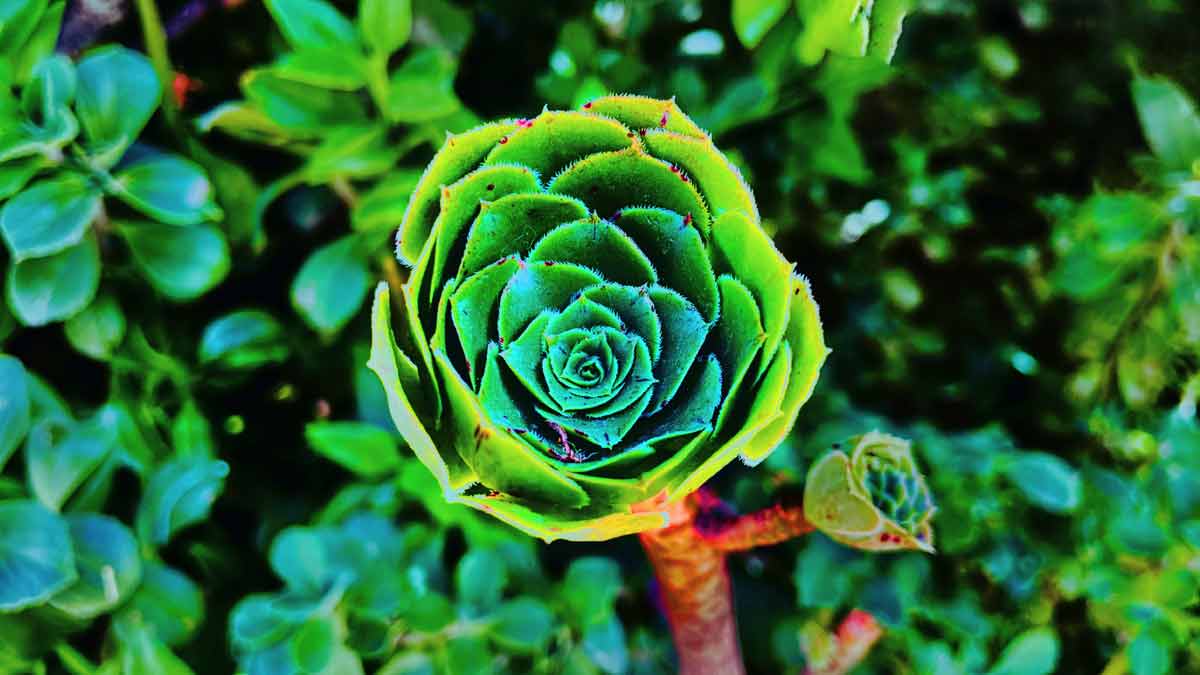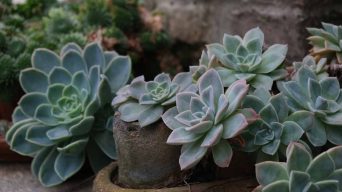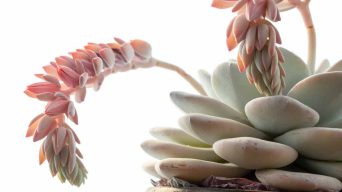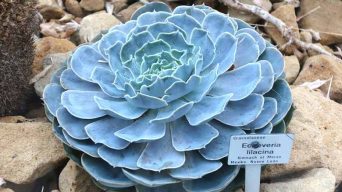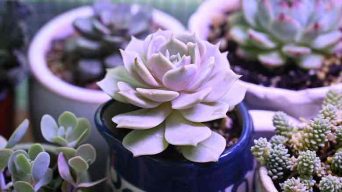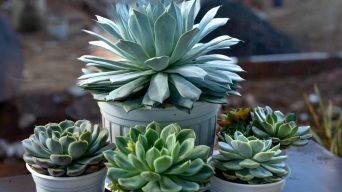Echeveria succulents are beloved for their striking rosette-shaped foliage and ease of care, making them popular among plant enthusiasts.
But what if your once compact and stunning Echeveria suddenly starts growing tall and leggy? Don’t worry – you’re not alone.
Etiolation, or lack of sufficient light exposure, is the primary cause behind this unwelcome transformation in your precious plant.
In this blog post, we’ll explore why your Echeveria is stretching out and losing its shape, how to identify an etiolated Echeveria, and discuss effective solutions to restore it to its captivating self.
What Causes Etiolation In Echeveria Succulents
Etiolation in Echeveria succulents typically occurs when the plant does not receive adequate sunlight.
As these plants are native to regions with abundant sunlight, such as Mexico and South America, they rely heavily on regular exposure to direct sun for healthy growth.
However, Echeverias may struggle to access enough light in indoor settings or shaded outdoor areas.
Consequently, the plant responds by stretching its stem towards potential sources of illumination—an attempt to maximize light absorption and maintain a healthy metabolism.
This leads to tall, leggy growth that lacks the distinctive rosette form commonly associated with this variety of succulents.
Unfortunately, prolonged etiolation in your treasured houseplant can weaken its structure and compromise overall health.
It’s worth noting that some varieties of Echeverias may be more susceptible to etiolation than others due to differences in their inherent light requirements or adaptability within varied environments.
How To Identify An Etiolatied Echeveria
Identifying an etiolated Echeveria is crucial for maintaining the health and aesthetics of your succulent.
An etiolated Echeveria will display some telltale signs primarily caused by a lack of adequate sunlight exposure.
For example, a healthy Echeveria should have a compact rosette shape with leaves clustered tightly around its base.
In contrast, an etiolated Echeveria might resemble more of a lanky flower stalk rather than the iconic succulent shape we all know and love – this stretching occurs in response to low-light conditions causing the plant to reach for sunlight desperately.
Don’t worry! Though diagnosing this issue might feel disheartening initially, understanding these warning signs allows you to address current problems and prevent them from recurring in the future.
How To Fix A Tall Echeveria Plant
If you have a tall Echeveria plant that is stretching out, you can remedy the situation by repotting it in well-draining soil and cutting back the stretched-out stem with sharp scissors or shears.
Repotting Techniques
Implementing proper repotting techniques is essential to address a tall Echeveria plant effectively.
Follow these steps to ensure success with your succulent:
- Choose a well-draining soil: Opt for a gritty, fast-draining mix like cactus or succulent potting soil to prevent root rot and promote healthy growth.
- Select the suitable container: Pick a pot with drainage holes that is only slightly larger than the root system of your Echeveria to encourage proper water retention and root growth.
- Gently remove the plant from its current pot: Loosen the roots and shake off excess soil without damaging the delicate root system.
- Trim any damaged or unhealthy roots: Use sterilized shears to remove dead or rotting roots before repotting to prevent disease and encourage new growth.
- Place the plant in its new pot: Position your Echeveria in the center of the container, ensuring it sits at an appropriate height – ideally with the rosette just above soil level.
- Add well-draining soil mixture: Carefully fill in around the roots with your chosen potting mix, gently compressing it as you go to eliminate air pockets without compacting it too tightly.
- Allow time for the plant to adjust: Wait about one week before watering your newly repotted Echeveria to give it time to acclimate and reduce stress caused by transplanting.
- Monitor growth closely: Pay attention to lighting levels, water needs, and any signs of distress during this transition period, making adjustments as necessary.
Following these repotting techniques will help restore balance to your tall Echeveria plant and promote healthy, attractive foliage in the long run.
Pruning Methods
Pruning is an effective method for fixing a tall Echeveria and keeping it in a desirable shape.
Here are some pruning techniques that can help:
- Use sharp and clean shears: Ensure your scissors or shears are sharp to avoid damaging the plant. Also, make sure they are clean to prevent any infections from spreading.
- Cut off the crown: The crown is the top part of the succulent, often the tallest and leggiest part of the plant. Cutting it off will encourage new growth from the lower parts of the plant.
- Remove dead leaves: Removing dead leaves will promote healthy growth in your succulent.
- Pinch off leggy stems: You can pinch or cut back leggy stems to promote bushier and more compact growth.
- Propagate cuttings: After pruning, you can propagate cuttings by allowing them to dry for a few days before planting them in well-draining soil.
Remember that pruning should be done regularly and gently throughout the growing season to maintain an attractive shape and size for your Echeveria succulent.
Propagation Tips
Propagating Echeveria succulents is an excellent way to replace leggy or tall plants, expand a collection, or create new ones.
Here are some helpful propagation tips to follow:
- Choose healthy leaves: Select plump and healthy leaves from the mother plant for propagation. Make sure they are free of pests, diseases, or damage.
- Dry out leaves: Allow the chosen leaves to dry out and callus over for a few days in a warm and dry spot before planting them.
- Use well-draining soil: Use a well-draining soil mix suitable for succulents like cacti mix, coarse sand, or perlite.
- Place leaves on top of the soil: Lay the dried-out leaves on top of the soil mix with their cut ends facing down.
- Wait for new growth: Water the soil gently, place it in bright but indirect light, and wait for new growth to emerge from the cuttings.
- Be patient: Succulent propagation can take time, so be patient and allow your cuttings time to grow into new plants.
By following these tips, you can successfully propagate your Echeveria succulent without any issues and watch as they grow into healthy new plants!
How To Prevent Echeveria From Growing Tall
To keep Echeveria from growing too tall, it’s important to ensure they have the right amount of light, water, and fertilizer.
You should also use soil that drains well and correctly prune them.
Optimal Lighting Conditions
Echeveria succulents thrive best in direct sunlight, whether indoors or outdoors.
If you intend to grow your Echeverias indoors, place them near a sunny window that receives at least six hours of natural light daily.
However, too much exposure to direct sunlight can cause sunburn on the leaves.
To avoid this, gradually introduce more light to your plant by exposing it to brighter conditions for a few hours each day until it’s used to the new lighting levels.
If you plan on growing your echeverias outside, ensure they receive bright but indirect sunlight.
Partial shade is also acceptable if it is bright and not completely shaded throughout the day.
Be mindful of moving clouds and obstacles that may block out some light; constantly shifting shade patterns will limit good growth potential for your echeveria plant species.
Watering Strategies
Proper watering is key to preventing Echeveria plants from growing tall and lanky.
Overwatering can cause root rot while underwatering can stress the plant and contribute to etiolation.
To keep your Echeveria healthy, only water it when the soil has completely dried.
It’s also important to use room-temperature water rather than cold or hot water, which can shock the roots and damage the plant.
Try misting your Echeveria occasionally during dry months to increase humidity levels and prevent leaf drop.
Soil Mixtures And Fertilization
Choosing the right soil mix is essential to prevent Echeveria from growing tall.
The ideal potting mix should be well-draining and have good airflow, allowing excess water to escape quickly and preventing root rot.
A typical succulent blend includes coarse sand, perlite or pumice, and regular potting soil in equal parts.
Fertilizing an echeveria should be done sparingly since over-fertilization can lead to weak growth and stretching of stems.
Use a balanced fertilizer diluted with water at half-strength during the growing season (spring through early fall) every two weeks.
You can also add some organic matter like compost or worm castings into the soil mix before planting to boost nutrients gradually without causing an imbalance in soil chemistry.
Maintenance Techniques
To prevent your Echeveria from growing tall, proper maintenance is key.
Here are some tips to keep in mind:
- Pruning: Regular pruning can help maintain the plant’s shape and prevent leggy growth. Use sharp, clean shears to remove dead or damaged leaves, branches, or stems.
- Optimal Lighting Conditions: Provide your Echeveria with adequate sunlight for healthy growth. Place it in a spot with at least six hours of indirect sunlight daily, or use grow lights if natural light is insufficient.
- Watering Strategies: Succulents do not require frequent watering; when you water them, give them enough water to soak the soil. Wait until the soil is completely dry before watering again.
- Soil Mixtures and Fertilization: Use well-draining soil mixtures and fertilize sparingly during the growing season to provide nutrients for healthy growth.
- Maintenance Techniques: Remove any dead leaves or debris from around the base of the plant to prevent rot and infestation by pests. Maintain room temperature water for its roots to penetrate faster into the soil.
Following these maintenance techniques ensures that your Echeveria remains healthy and does not grow too tall due to stress or lack of proper care.
Common Echeveria Varieties Prone To Etiolation
Etiolation is a prevalent issue among various Echeveria varieties; understanding which types are more likely to experience this problem can help you better care for your succulents.
Below is a table of some common Echeveria species that are prone to etiolation:
| Echeveria Variety | Reason for Etiolation |
|---|---|
| Echeveria Elegans ‘Mexican Snowballs’ | Popular for its compact form, this variety stretches easily if not receiving enough sunlight. |
| Echeveria Agavoides | Though known for its robust structure, it can still grow tall in low-light conditions. |
| Echeveria ‘Perle von Nurnberg’ | Its attractive purple hue can fade, and the plant can stretch when not provided with sufficient light. |
| Echeveria ‘Black Prince’ | Requiring bright sunlight to maintain its dark color, this variety quickly grows tall in low-light environments. |
| Echeveria Runyonii ‘Topsy Turvy’ | Despite its unique curved leaves, this plant can lose its distinct appearance if not given enough sunlight. |
By recognizing which Echeveria varieties are more susceptible to etiolation, you can take proactive measures to ensure your plants receive the optimal amount of sunlight and maintain their stunning appearance.
Final Thoughts
If you notice your Echeveria growing tall or stretching out, it’s a sign that your succulent needs more light.
Etiolation can affect the shape and growth of your succulent, but there are ways to fix it.
Repotting in well-draining soil and pruning with sharp shears can help restore healthy growth.
Prevent future etiolation by providing sufficient sunlight exposure, watering correctly, and fertilizing appropriately.

